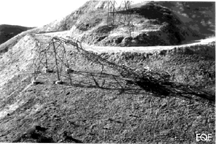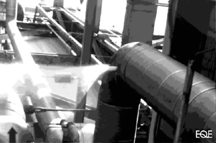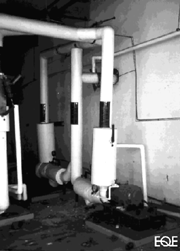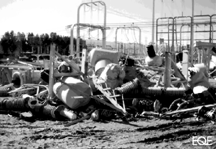-


Left: Some transmission towers collapsed because ground failures affected their foundations.
Right: This leak in a power plant welded pipe elbow was caused by the earthquake.
Electrical power systems in the affected area are operated primarily by the Los Angeles Department of Water and Power (DWP) and the Southern California Edison Company. Some areas, such as the cities of Burbank and Glendale, are served by smaller municipal utilities. Most of the generating capacity for the Los Angeles Basin is located outside of the heavily shaken region; however, both ac and dc bulk power transmission lines for Los Angeles enter the region through the northern San Fernando Valley, within a few kilometers of the epicenter. Generating stations within the affected region were subjected to moderate levels of ground motion, while several substations and converter stations were subjected to very strong ground motion. Earthquake damage to transmission towers, dc converter stations, and substations resulted in widespread local and isolated remote power outages lasting from minutes to several days. Earthquake-related power disruptions were reported in seven western states and in British Columbia, Canada. Generating stations, however, sustained only minor damage and were generally available for service soon after the earthquake. Electricity was restored to virtually all customers within one week after the event.

Severe damage to pump and piping supports was caused by inertial forces imposed by poorly braced piping.
Power Plants
As part of a post-earthquake investigation sponsored by the Electric Power Research Institute (EPRI), EQE engineers toured the Valley Generating Station, just south of San Fernando; the Burbank Power Plant; and the Glendale Power Plant. The plants are operated by the Los Angeles DWP, the City of Burbank, and the City of Glendale, respectively. Further investigation of these plants as well as facilities located farther from the epicenter will continue. These plants were also affected by the 1971 earthquake and were studied in detail.
The Valley Generating Station, located closest to the epicenter (13 km away), includes two 95-megawatt (MW) units (Units 1 and 2) that were not operational at the time of the earthquake and two 160-MW units (Units 3 and 4) that were on cold-standby when the earthquake occurred. Preliminary strong-motion data and damage assessments indicate that the facility had about the same level of shaking as during the 1971 San Fernando Earthquake, approximately 0.4g horizontal peak ground acceleration. The facility had minor damage such as cracks in steel struts, a twisted wide flange, distorted exhaust duct insulation panels, damaged piping insulation, inoperable combustion air instruments, leakage in a welded condensate line, and superficial damage to building elements. Numerous relays had to be reset prior to restart. The damage did not prevent plant operation, and Units 3 and 4 were successfully brought on-line several hours after the earthquake. The plant continues to supply power to the region.
The Burbank Power Plant consists of two facilities, the five-unit Magnolia plant and the four-unit Olive plant. At the time of the earthquake, two units were running and one unit was on hot-standby. All units tripped off-line due to fluctuations in the power grid. Damage was limited to a broken PVC line, spalling at tank footings, failure of small-diameter pipes, deformation of tank anchor clips, and damage to a crane. The plant’s combustion turbine units were brought on-line soon after the earthquake, followed by the steam units.
The Glendale Power Plant has five natural-gas-fired boilers ranging from 20 to 44 MW and several smaller gas turbines. Two units were running at the time of the earthquake and tripped off-line upon fluctuations of the power grid. Damage and failures included bearing damage to the Unit 5 turbine caused by loss of lube oil, rupture of 61-cm-diameter cooling tower inlet risers, and superficial damage. Power to the facility was restored on the morning of the earthquake, and units—excluding Unit 5 pending bearing inspection—were brought on-line as needed soon thereafter.
Substations
High-voltage electrical transmission facilities affected by the earthquake included the Sylmar (ac and dc), Rinaldi, “J,” Pardee, and Vincent substations. Damage sustained by 230- and 500-kilovolt (kV) transmission apparatus ranged from minor to substantial, depending on the severity of ground motion and the adequacy of seismic design features. Substation damage was the primary reason for widespread local power outages and isolated remote outages across seven western states and British Columbia. Isolated instances of transmission tower structural failures caused by ground failures were also reported.
The performance was consistent with observations from past earthquakes, where damage typically occurred to high-voltage substation power apparatus (230 and 500 kV) supported by brittle ceramic insulators and subjected to strong ground motion. Newer equipment that are specifically designed for service in high-seismic zones should be reliable at seismic accelerations of up to about 0.5g. Several substations affected by the Northridge Earthquake underwent horizontal peak ground accelerations much greater than 0.5g, and in some cases, accelerations approached and may have exceeded 1.0g.
High-voltage substation apparatus designed after the 1971 earthquake and engineered for high-seismic zones generally had substantially less damage than did older equipment. Observed and reported damage indicates that additional research and engineering need to focus on the isolated failures of relatively new apparatus, particularly in unique apparatus that convert bulk dc power to ac power for local transmission and distribution.

High-voltage substation equipment failures were attributed to damaged brittle ceramic insulators. Damaged equipment were placed in storage during repairs.
Cogeneration Facilities
The several modern cogeneration plants that were within the region affected by the Northridge Earthquake performed well. These plants support a variety of large facilities, including hospitals, data-processing centers, petrochemical plants, and large office buildings. The central plants generally provide electricity, heat, cooling, and other services, depending on the type of facility.
Some cogeneration facilities were located within a few kilometers of the epicenter; others were at more distant locations. A 6-MW gas turbine unit was subjected to 0.9g ground motion and was operational within a few hours. A 25-MW gas turbine unit was located in the Santa Clarita Valley and was also operational within a few hours. Some of the smaller facilities were in areas that had substantial structural damage to surrounding buildings. Preliminary investigations indicated that control logic malfunctions were a significant factor in delaying restart of the units that were undamaged after the earthquake. In one case, automatic closure of a seismic gas shutoff valve isolated gas to the boiler. Backup power to restart the boiler was provided by a manual-start diesel generator.